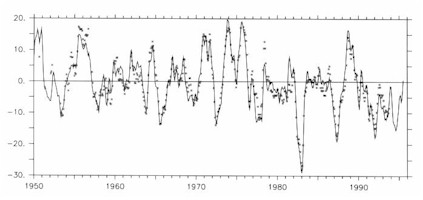
U.S. Dept. of Commerce / NOAA / OAR / PMEL / Publications
The Tahiti and Darwin SLP time series and other derived quantities, particularly the Troup Southern Oscillation Index (SOI), have been widely used in ENSO research because they offer a long-term look at an important measure of the Southern Oscillation. They also offer us a standard against which the COADS SLP data can be compared; were the COADS SLP data unable to reproduce the SOI, it would be difficult to argue for further use of COADS in ENSO studies. In this Section we describe the construction of surrogate "tahiti" and "darwin" time series from COADS, and compare these with the land station data. We have not undertaken a systematic comparison of COADS SLP with other WMO island station SLP records, both because we did not have easy access to the WMO station data set, and because of the larger quality control issues involved in using the WMO data.
To construct the surrogate "tahiti" and "darwin" time series we use the same spatial smoothing (nine-point binomial in longitude, seven-point binomial in latitude, see Section 2) as used to construct the composite, and then pick two points, one near Tahiti and one near Darwin, that are as close to the real stations as possible while making best use of the available data. Our surrogate "tahiti" is chosen as 151°W, 17°S; our surrogate "darwin" as 137°E, 11°S (Tahiti is located at 149.6°W, 17.5°S; Darwin at 130.9°E, 12.4°S).
We find somewhat less variability in the surrogates than in the original time series. The "tahiti" surrogate maximum amplitude is less than Tahiti by about 1 mb, which appears to be the result of area averaging. Averaging over a smaller region yields more similar extreme values, but leads to more gaps in the time series and increased high frequency variability. However, both surrogate series duplicate to a high degree the major low frequency features of the original series. We have examined the anomaly time series as well and find very good correspondence in all of the low frequency features, but differences in high-frequency detail.
A more demanding comparison is how well the surrogate time series can be combined to reproduce the Troup SOI. We calculate a surrogate Troup SOI identically to the way in which the Troup SOI is calculated (McBride and Nicholls, 1983) except using our surrogate "darwin" and tahiti time series. Surrogate COADS Troup SOI = 10* (anomaly of surrogate tahiti minus anomaly of surrogate darwin)/(standard deviation of the record of that calendar month's difference). Figure 4 shows the comparison of the 5-month triangle time-smoothed Troup SOI and the COADS surrogate Troup SOI; correlation statistics on the raw series and time smoothed series are presented in Table 1. The correlations are high, and extremely high when a triangle smoother is applied.
Fig. 4. Troup SOI (solid line) and our COADS "surrogate" of Troup SOI (symbols). Both are shown time smoothed with a 5-month width triangle filter.
TABLE 1. Correlations between Surrogate and Station
Time Series
(Graphic image of table)
No time |
5-mo |
13-mo |
|
| Tahiti SLP | 0.94 |
0.98 |
0.96 |
| Darwin SLP | 0.96 |
0.98 |
0.96 |
| Troup SOI | 0.86 |
0.96 |
0.99 |
Return to previous section or go to next section